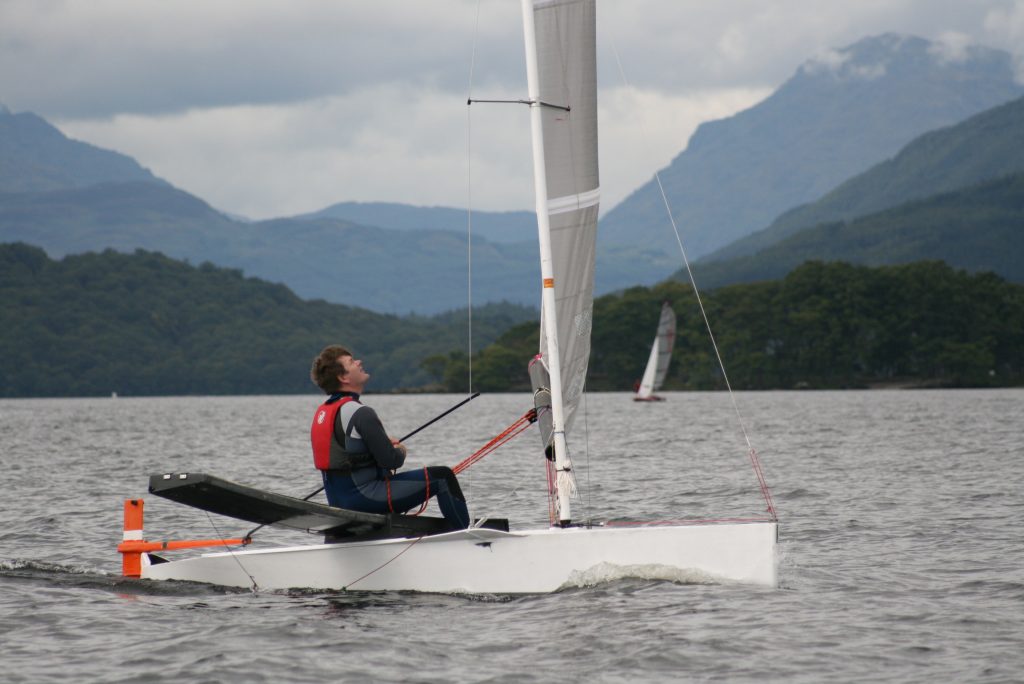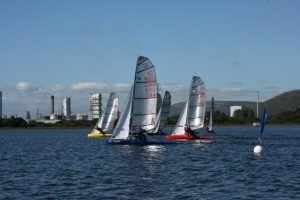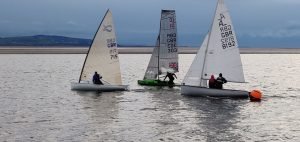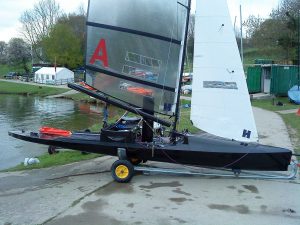Alistair Warren describes his thought processes in the design, build and development of his new rules IC…..
I have sailed canoes since 1989, going to the worlds for the first time in 1996 coming 9th. I was keen to build my own, but could not see the point of building a nethercott as plenty of better builders than me had built them and I was not interested in the asymmetric. I graduated away from the class, building and sailing Phantoms for a few years.I started looking at the design for Monkey as soon as Steve Clark posted his original proposed new rules. At the time I had just started at Racing Technology Norfolk in their design office, having worked there on the shop floor when they were running the Team Bentley Le Mans programme. Designing Monkey was good practice with the CAD system Pro-engineer. The idea was to make a boat that was easy to sail, i.e. not too extreme and as simple as possible. I gave her 100mm of rocker, mostly up the front and kept the max beam to 900mm. The hull is hard chine as that was the simplest way to make the buck.
Construction progressed and I decided to make the hull over a male buck using 2 plies 200gsm carbon either side of 8mm 80gm3 in areas that I thought were stressed, i.e. from the mast foot back to where the seat tracks would finish, elsewhere there was 1 ply of carbon either side of the foam. Also on the bottom there was some glass of dubious origins and weight. It was all wet laid, and vacuum bagged in several goes. The foredeck was made from a mould I had taken off GBR240 some years ago and I used some nomex I had laying around for that. The rear deck under side was laminated then while still wet pushed into place. Once cured it was then vacuum bagged over the top, not a great idea as I was later to find some of the carbon fell off underneath.
The foils were some that I had made for 240, the mast was a repaired one I had brought in bits from George from his asymmetric canoe. The boom was a cut down section that I had made for the Phantom that had not quite worked right. For the seat I made a mould. The first seat never even made it to the water, far too lightly built, the second I could problary use as a road bridge for Lorries.Originally I opted for a single sail to try to make the boat simpler, this was not particularly well executed and made the boat very hard to tack, but in a straight line she still went well. Two reasons that it was not too good were that the sail was too full and the dagger board was too far forward. After the Loch Lomond Europeans having sailed the boat only a few times I decided that a trip to OZ in its current state was a waste of time, so I chopped out the bulkhead where the mast sat and the dagger board slot, stuck it all back together with the mast and dagger board in positions that I had taken from John Ellis’s boat some years ago (Wild Thing I think). With a new set of sails I managed to get 1 open meeting in before the boat got packed up for OZ.
In Oz the boat went OK, however String theory was significantly faster. I had a few good starts near Chris and he just pulled away from me. Fortunately Monkey went fairly well off the wind. I had some good racing with Oliver Moore and Steve Clark, who both came in front of me in the results.In my mind the boats there that had potential were Phil Robins Scarlet O Hara and John Kells boat Mayhem. Both were to some extent unfinished and neither reached there potential. I was not very keen on Steve Clark’s boat, but was well sorted out and well sailed. Geoff Harman’s boat was a nice shape but the rig was well of the pace. It goes without saying that String Theory was fast and very well built. Dels boat, Donkey was an unfinished project when he got there and was difficult to see if it had potential. Hollow Log was interesting, well sailed but I am not sure if anyone else would follow down Phils own very individual route.For me the only way to go in terms of construction is carbon foam sandwich, I think building out of ply is always going to be difficult to get the boat down to weight, however just because you use carbon foam does not mean that the boat will be light, my all up weight at the worlds was 63kg, 13 kg over weight.
It did not help that I had a 12 kg seat, the result of under building the first one which I then over compensated for. In the hull two plies of carbon either side of the foam were also not required and adding the extra random amount of glass did not help.So, what have I learnt? It’s great to sail a boat you have designed, built, tested and rebuilt, even when it’s not the quickest or best looking. I would recommend it to anyone. It may seem that I have a huge advantage being in the composites industry, however the techniques used in my shed are far removed from those we use at work. We exclusively use prepregs and autoclaves for moulding. CNC machineing for pattern work from epoxy tooling block at £5000 -£6000 /m3 so my wood pattern work and wet layup is quite different.
In terms of design the next boat needs to be lighter more robust and have the rocker further aft. It really needs to be 850 wide on the deck rather than the 900. Also the measurement point I am moving back from approx 2000 from the rear to 1500. I will need of think of different ways to build it quicker as my family is growing and I am not keen on spending another whole year of weekends and evenings in the shed.The next boat is on the CAD system (new system, new company!), in fact I have about 5 different boats on the CAD system, one will eventually be built some time, not sure when. First thing to do is a new seat mould; the mould I used for the current seat was not good enough and has been chopped up. Pattern work had been started but I managed to twist it while gluing up so its scrap, but this gives me the opportunity to refine the design.
I hope now to be in the class for a good number of years. It provides me with the challenge of design and sailing that attracts me. Eventually there will be further designs and boats, hopefully a new one for each worlds if possible.
Alistair Warren.
Since writing this I have had a chance to do some more sailing. Monkey seems to have a definite groove, at a certain wind speed she picks up and goes much faster, but before that point she is about the same speed as a nethercott. Scarlett is faster, I am not sure if this is due to Phil sailing more this year, weight (I am about 10 kg over weight and the boat 13 kg) or design. Scarlett is particularly fast on a reach. Ideas for the next boat have progressed, I must have about 20 different models. A more Chris style transom I think is the way to go and I need more rig adjustment. A self tacking jib I think will help, but I still like the jib boom. I have had machined some moulds for the foils and have made a rudder blade which works well, but I have been doing some houses up so progress in the shed is slow.




